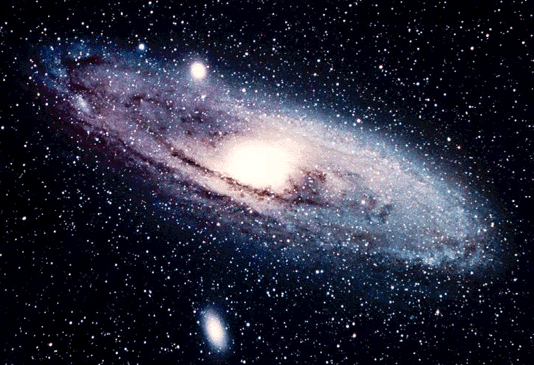The Milky Way galaxy is a relatively big spiral galaxy. So is Andromeda. There are about 20 dwarf galaxies that are gravitationally bound to us; combined with us, all of this makes up the local group. But Andromeda is moving towards us, and eventually, it's going to merge with us. I'll once again show you a video of what this merger might look like:

But Andromeda is also very far away: about 2.3 million light years (770 kpc). The center of it is tiny on the sky, but the whole galaxy, as seen above, is actually 4 degrees across, or eight times larger than the diameter of the full moon! Its apparent magnitude is 4.4, which means it can barely be seen with the naked eye (anything less than 6 can be seen with your eye) if your vision is good and there's no light pollution.
But the Universe will continue to age, and gravity will basically tell Andromeda "Get over here!" When this happens, Andromeda not only gets closer to us, but also starts to appear bigger and brighter in the sky. What does this mean? Let's play Zeno's Paradox, and see what happens when it gets halfway to us, and then halfway of that distance, etc.
- About 1.9 billion years from now, Andromeda will be 385 kpc away from us. It now has an apparent magnitude of 2.9, which means it's just barely visible from most urban neighborhoods, and appears slightly brighter than our own Milky Way does. It now takes up 8 degrees on the sky, making it 16 times as large as the Moon in diameter.
- About 2.7 billion years from now, it will be within 190 kpc of us. That's still well outside the Milky Way, which is less than 20 kpc in radius. It's now quite bright, though, with an apparent magnitude of 1.4, making it as bright as one of the brightest stars in the sky, Regulus. It is now 16 degrees on the sky. If, at this point, it were oriented face-on to us, it would take up about 1% of the entire visible night sky.
- About 3.2 billion years from now, it will be under 100 kpc from us. It now takes up 1/20 of the entire night sky, and only the Moon, the Planets, and three stars, Sirius, Canopus, and Alpha Centauri are brighter than Andromeda appears.
- 3.4 billion years from now, Andromeda will be within 50 kpc of us, on the verge of beginning to merge with us. (Remember, it has a radius of about 20 kpc, too.) Its apparent magnitude is -1.5, meaning that it is now brighter than any star in the sky. It will now take up about one-fifth of the night sky, and will just begin to create new star-forming regions in the outskirts of the galaxies, where the gas begins to merge.
And then the merger happens. What will that do to us? Take a look:


This is great. I love how you have depicted the possible outcome of two galaxies merging as one. It is truly a sight to see. Luckily, for humans anyway, before the great collision, we will have a front row seat from Heaven to watch this unfold. Great work!
"Time to find a new galaxy... or at least a temporary home outside of ours while that merger takes place!"
I wonder if any alien apartment owner's are willing to sign a billion earth-year lease while we wait for things to calm down.